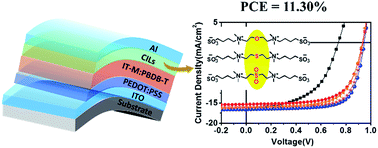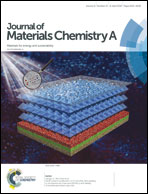Highly efficient non-fullerene polymer solar cells enabled by novel non-conjugated small-molecule cathode interlayers†
Abstract
The interface strategy has been identified as an effective process to optimize the overall performance of polymer solar cells (PSCs). Herein, three novel non-conjugated small molecules comprising amino cations and sulfonate anions, as well as various core atoms of oxygen, sulfur, and sulfone, were successfully synthesized and employed as cathode interlayers (CILs) for non-fullerene PSCs. A large improvement of the device performance was observed, in which the solution processed sulfur-based CIL shows excellent cathode modification ability and device properties with the highest power conversion efficiency (PCE) of 11.30%. Compared with the vacuum deposited Ca, the non-conjugated small-molecule CILs could significantly increase the charge transport and collection capabilities, decrease the work function (WF) of the Al counter electrode, and reduce the series resistance and charge recombination at the interface. Most importantly, these simple water/alcohol soluble CILs are of great significance and suitable for the low-cost and large-area preparation of PSCs.



 Please wait while we load your content...
Please wait while we load your content...